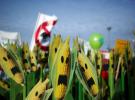Smoke and Ash Made More Toxic by the Contents of Burning Homes Threaten Residents of LA and Beyond
Public health officials and researchers urge the public to cover up outside and clean carefully indoors, but many low-income and disabled residents, and those lacking air conditioning, have difficulty staying safe in bad air.
The air here has many flavors this week, none of them reassuring: Smoky. Acrid. Unidentifiable.
Ash is everywhere and comes in many sizes, from black and gray slivers collecting along curbs to a suspended white dust that settles on smartphone screens. Craving a sense of recovery instead of daily updates on the containment of the fires plaguing the city, neighbors compare air quality apps, debate the advantages of N95 versus KN95 masks and the best filters for any available air purifier they can find.
Hundreds of thousands of apartments and single-family homes in this Mediterranean climate have no AC or central filtration system. Windows are taped up. A county of 9.6 million people, whether they lost homes to the fires or not, suddenly have one thing in common: the poisoned cloud blanketing them, raining down particulate matter that public health officials warn is toxic and carcinogenic.
“Assume the worst,” said Sarah Rees, a director at the South Coast Air Quality Management District. “When you see that ash, take the precautions needed to protect yourself and protect your health.”
Wildfire researchers across the country watching the SoCal disaster are equally alarmed.
“It’s just terrible on all fronts, in terms of the health impacts,” said Chris Lim, an air quality researcher at the University of Arizona. “A long-term concern is that a lot of these toxic gases or VOCs [volatile organic compounds] will get into homes and linger for months.”
The chemical composition of the smoke and ash in Los Angeles right now is different from forest fire smoke, which is plenty toxic on its own, said Lim. The more than 40,000 acres that have burned since last week in LA included more than 12,000 structures and everything around them, from cars to infrastructure. The firestorms that began 10 days ago are releasing chemicals from electronics, laminated floors, treated wood, paint, metals, cleaning products stored under sinks and an incalculable volume of plastics. Fallout from urban fires typically includes heavy metals like lead and mercury along with PCBs and noxious gases, all of which are now hovering over or landing around homes of Angelenos.
Significant exposure to urban wildfire pollution carries both acute and chronic impacts for human bodies, said Rima Habre, an environmental health scholar at the University of Southern California who lives in Los Angeles. During and immediately after wildfires and urban conflagrations, those with compromised respiratory systems, cardiovascular issues or any condition related to inflammation are likely to feel the impact. Incidences of heart attacks and strokes go up right after firestorms. Habre says more research is needed on potential long-term effects, but what’s been proven so far is harrowing. The “chronic” impacts include lower birth weights, enduring lung conditions in children, a variety of cancers in adults and increased cases of dementia.
“The biggest impacts are the mental health ones, long term,” says Habre, referring to everyone experiencing the regional crisis and its toxic-air aftereffects, not only those who lost homes. Anxiety. Depression. Trauma responses with their crippling triggers. And bigger picture, she notes that people are collectively processing the recent barrage of worst-case scenarios come to life: “With climate change, there’s an expectation that these things could happen more often.”
Cover Up and Clean
As the portion of the fires that have been contained inches up day by day, health officials and scientists are warning the outdoor-loving citizens of Los Angeles to not get complacent about toxic exposure once the flames finally die out.
“There are going to be a lot of dangers related to cleanup,” says LA County Health Officer Dr. Muntu Davis, who’s already banned the use of leaf-blowers to avoid stirring toxic, fallen ash back into the air. “It’s hard to have everyone get the message.”
But there’s some hope in that message, or at least a greater sense of agency, with officials and researchers offering practical advice about how to reduce exposure now. Their recommendations, which are valuable to any community in the country confronted by smoke waves from wildfires and urban firestorms, include:
- Limit your time outside, full stop.
- When you do need to go out, N95 masks (the ones with double straps that go over and under the ear) are recommended for post-fire protection because of their tight seal. When in a car, run the AC and set it to “recirculate” (the button with the looping arrow).
- Never allow ash to touch your skin or eyes. If you are attempting to clean up outdoors, wear a hat, goggles, mask, long sleeves and pants. Take off your shoes before you re-enter your home. (If you have pets, use paw-covers and bathe them often.)
- Inside, tape up any gaps or leaks around windows, and if you have AC or a central fan, run it on recirculate. If you are using an air purifier instead, look for filters labelled with both HEPA (to catch particulates) and “activated carbon” (best for catching VOCs). Replace filters every few weeks. A third, affordable option is this DIY air purifier, made with a box fan, but make sure to get appropriate filters for the rig.
- Ramp up your indoor cleaning routine, understanding that smoke and ash will make their way in through doors and windows. Wipe down walls and surfaces, mop often (especially if you have children playing on the floor), and use a vacuum with a HEPA filter. “Wet is best”: moisten paper towels or rags to collect dust and then dispose of them in trash bags—rinsing in sinks will only introduce more toxins to the public water system.
- Launder all linens and children’s stuffed animals.
Monitoring air quality is an imperfect science, stressed Rees from South Coast AQMD. While it’s helpful to check the Air Quality Index (AQI) levels on apps, large-particle pollution (like ash) and gaseous VOCs are not included in the index. She suggests signing up for regional air advisories (like this one for the southern coast of California) that cover more variables.
County and regional officials are not offering specific timelines for how long the high-alert air quality conditions might last, but more than one have used the phrase “long haul.” On Wednesday, the LA Country Public Health Officer prohibited the removal of debris from burn sites “until a hazardous materials inspection is completed by an approved government agency.” Municipalities like Santa Monica, which sits just south of the Palisades fire zone, have posted social media reminders about air quality warnings and best-practices for self-protection on a daily basis this week. Wednesday, the City of Pasadena declared a local public health emergency “due to the widespread impacts of Eaton Fire, including the presence of ash and particulate matter in the air throughout the community.”
As hard as it is to accept that the dangers will linger and even expand, Habre noted that most of the United States has been experiencing diminished air quality in the past few years as a result of wildfires in the Western U.S. and Canada. A preliminary case study published by American researchers last year suggested that wildfire air pollution can land and even stay trapped in urban “basins” (based on topography and weather patterns) far away from the fires. So the air quality threat from LA right now is not only a matter of duration but also expansion. Lim said he expected the impacts to be, to some degree, “transcontinental.”
“Barrier After Barrier” for the Most Vulnerable
Pulling off any of those preventative protocols from a wheelchair that has ash caught up in its tires, however, presents another level of challenge.
Rudy Contreras runs Southern California Resource Services for Independent Living, a nonprofit founded and managed by people with disabilities. The office headquarters are on Altadena Drive, right below the 210 in Pasadena, near where the Eaton Fire broke out last week.
“The fire wasn’t there but the smoke was,” says Contreras. “Our offices got shut down because power went out and the smoke drowned our HVAC system.”
Knowing many clients would be in crisis immediately, Contreras rushed to set up operations from his home.
“We had several individuals contacting us saying their apartments were filled with smoke,” he said. “The level of smoke that blew into these units! It’s stuck on the furniture now like sludge, infused into these households, and that’s what you’re breathing in.”
One family told Contreras they were already too ill to stay, so he began searching for options to evacuate them quickly. He offered to get a hotel room that night, but the family didn’t have access to transportation. Contreras, who also has a disability, spent hours piecing together a solution: He discovered that Airbnb had launched an emergency temporary housing program for evacuees, while Uber and Lyft were offering discounted rides. The family was able to evacuate to a one-week Airbnb in Alhambra, 20 minutes away.
But that was just one crisis call. There have been many more, mostly about air quality.
“I’m telling people, ‘You need to go to your healthcare physician immediately. We don’t know what you inhaled,’” says Contreras.
Now that power has been restored on Altadena Drive, he’s hoping to re-open the office this week. One thing he has for clients now is N95 masks—he’s kept them in stock by the thousands ever since COVID. But house cleaning, air purifiers, safe transportation and accessible long-term evacuation options to limit smoke and ash exposure are all daunting.
“It’s been barrier after barrier, and there’s some depression. People are sad. They’re asking, ‘What’s next? How do we do this?’” said Contreras. “I don’t have all those answers.”
Cover photo: Smoke and flames overwhelm the Altadena area of Los Angeles County during the Eaton Fire on Jan. 8. Credit: Josh Edelson/AFP via Getty Images




